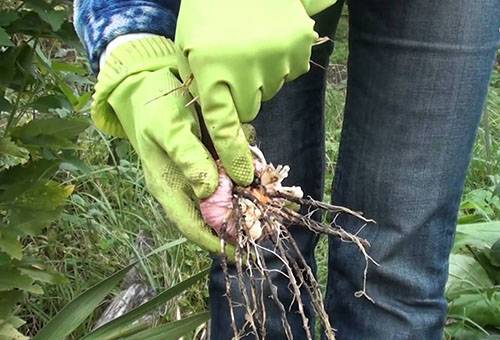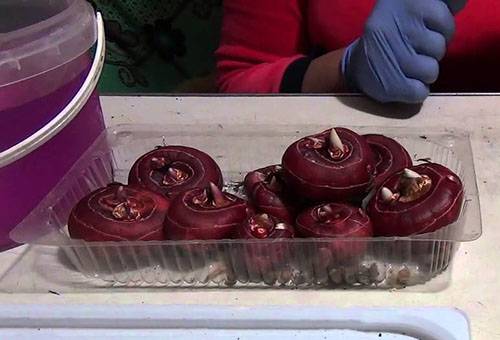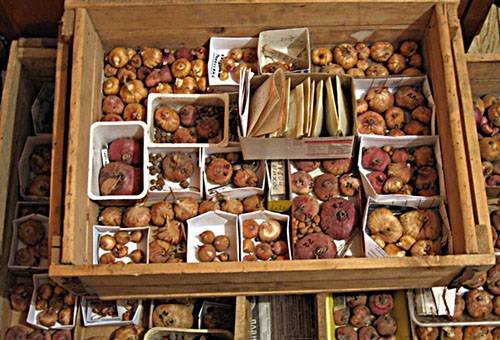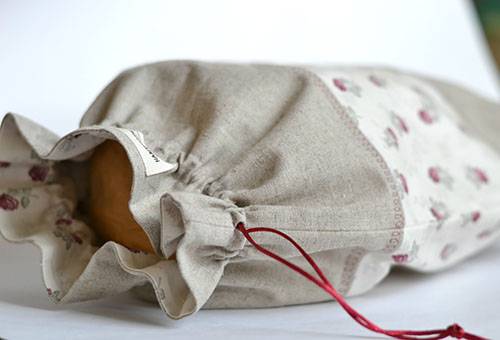Useful tips for cleaning and storing gladioli in winter
Content:
It is important for flower growers to know how to organize storage of gladioli in the winter. After all, these plants die when the temperature drops well below zero or the frost lasts for many days. So corms need to be removed to ensure their safety and proper care. Landing will be made in the spring.
When and how to remove gladioli?
Harvesting should be carried out after the ripening of the bulbs. This occurs a month after flowering in the early varieties and a half - in the later. Typically, the harvesting period falls in the second half of September, but in areas with different climatic conditions it can be shifted. If the plant releases the inflorescence too late, it should be cut. Otherwise, it will be necessary to dig out an unripe bulb, which may not rise in the next year, the landing will be unsuccessful.
Cleaning is carried out before the onset of constant frost. The corms can withstand a slight drop in temperature, but at -5 degrees care is needed: the bed should be covered with mulch. When the necessary time after flowering has passed, you can start digging the bulbs. They do this in the following order: first, early varieties, then early-medium and medium flowering, then later. End with bulbs that have grown from tuber buds. It should be borne in mind that varieties with flowers of dark shades and lavender-blue quickly lose their protection against fungal diseases. Therefore, with other equal nuances, the procedure begins with them.
Bulb harvesting is preferably carried out in dry weather. If the soil is moist, then part of the so-called “children”, tuber buds, will remain in the ground. In a mild climate or provided that the winter is not cold, they can germinate. As a result, a quality planting of a certain variety will be clogged. But in cases where the weather does not go well, you should not wait too long, you should dig out the gladiolus on time. Do this with the help of forks with wide teeth or shovels. With a tool, plants are picked up, capturing part of the soil, and gently brushed over a pre-lined film. Thus, the "kids" will not be scattered throughout the garden. Sick bulbs must be immediately separated from the rest. They are put in a separate container, and then destroyed.
Onion preparation before drying
Next, you need to process the bulbs in order to prepare them for storage at home in the winter. Care looks like this: first pruning shears, pre-sanitized, cut off most of the stem to get only a small stump, and the roots. Then carry out the removal of the maternal bulbs. Some gardeners prefer not to do this to preserve nutrients. But in this case, the risk of infection of the plant increases. Therefore, it is recommended to leave only a substitute bulb. In addition, if you remove all unnecessary, drying will be faster.
It happens that the maternal corm is not able to be separated immediately. It will be necessary to return to this procedure in two weeks. Care will become easier: after drying, it will be possible to do this without any special difficulties. In bulbs grown from tubers, the roots should not be removed. It is enough to cut a little, otherwise they can dry out and landing them will be useless.
To protect gladioli from various diseases, they must be thoroughly rinsed under running water, and care may include treatment with disinfectants. Two solutions are prepared for this:
- in 10 l of water add 20 g of chlorophos;
- for the same amount of water - 10 g of potassium permanganate.
In turn, corms are kept in these fluids for 20 minutes. It does not hurt to leave them in hot water (50 degrees) for the same time, then cool in cool. After such procedures, gladioli are ready for drying.
Tip
Paraffin reliably protects from overdrying and fungi. The substance must be melted in a steam bath and dip into the mass of each onion.
Since recently more and more gardeners have been dealing with such a pest as thrips, it makes sense to include in the care treatment of bulbs from it at home. This insect infects leaves and flowers, nullifying all efforts to grow gladioli. It will suck out nutrients from them in the winter, which will lead to drying out. Thrips in the bulbs overwinter; therefore, it is important to sanitize them qualitatively. The preparation "Decis" is well suited for this. One ampoule of the agent is added to 5 l of water, tubers are lowered into the resulting solution for 40 minutes. The container on top must be covered with a film. After 4-5 days, you can use the drug against fungal diseases, for example, "Maxim". One ampoule is dissolved in 2 l of water and the plants are kept in the mixture for half an hour.
How to dry the bulbs?
Further care is to dry the bulbs. They are laid out in boxes made of cardboard or wood, and taken out to fresh air for a couple of hours. Then leave for a week in a warm place, the air temperature should be at least 20 degrees, even better - 30. It is allowed to place near fan heaters and heaters. Corms are better to overdry, otherwise they are likely to be infected with bacteria and fungi. As a result, spring planting will not give the expected effect, many plants will not sprout.
The next 2 months after the bulbs were harvested, they are stored in a room with a normal temperature, 20-22 degrees. Care is also important during this period: they must be ted and turned regularly so that they are dried evenly. After this period, all planting material should be reviewed. If damaged specimens with signs of illness are found, then they must be removed and destroyed. In cases where the variety is rare and expensive, and problem areas on the bulb are small, they can be cut. This place is then greased with brilliant green.
If there is a high probability of plant infection with thrips, then it makes sense to break off the stump remaining from the stem. The place where it goes into integumentary flakes is best suited for the life of the pest. Thus, the insect will remain unprotected. But as a result of this procedure, the risk of drying out of the bulbs increases. Therefore, if thrips has not been seen, it is worth leaving everything as it is.
How to store?
After high-quality corms are selected, they are prepared for further storage at home. To do this, they are laid out in bags of breathable tissue. A non-woven covering material is well suited for this purpose, it is very easy to sew a bag from it yourself. A label with important information is put into each of these storages: variety, collection time. It is convenient to make it out of thin tin, then nothing can be damaged. On a tin strip with a pen, data is caught and outlined with an alcohol marker to easily read if necessary.
After preparation, the plants are placed in a cool, dry place. The temperature should not rise above 8 degrees. The basement is good, but not the one in which the vegetables are stored: they give off moisture. Can be stored in the refrigerator on the lower shelves.
The tubers are not dried for long, two weeks. Then they are put in bags, signed and sent to wait for the winter in a cool place, like adult bulbs. Every month, all plants are reviewed to detect diseased specimens in time if they appear.
Caring for gladioli is not easy, especially in winter.But if the cleaning was done on time, all storage conditions are met, then the spring planting will be successful and soon the area will be decorated with exquisite flowers.
Check out the article: can I water the flowers with tea



